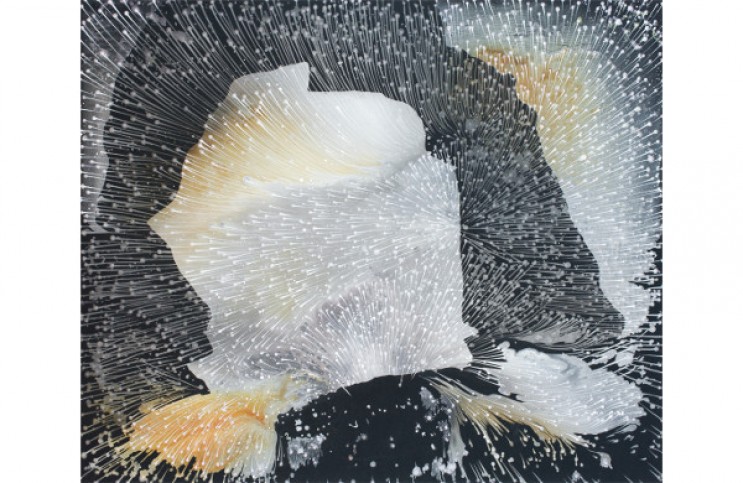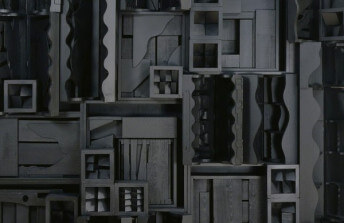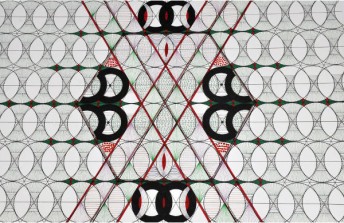Barbara Takenaga's Fluctuations of Space
Sep 19, 2018
DC Moore Gallery in New York recently opened Outset, a solo exhibition of new paintings by Barbara Takenaga. These paintings, however, might be better described as worlds. They possess a sort of gravity, or at least magnetism, pulling the eye inward towards some unceasing depth. Visually, they express aspects of the most mysterious realms of physical existence: cosmic and microscopic space. But these are not really pictures of inner or outer space, or of anything recognizable. They are abstract manifestations of the essence of a dream world, a fabrication of the artist. Takenaga begins each composition with a single dot of paint on the surface. From that point a constructed world expands, an illusionary space, happily swirling among the dots and lines and ephemeral clouds. Viewers report feeling an undeniable physical attraction, pulling them closer to the works, compelling them to gaze for long periods at a single canvas, happy perhaps to never emerge from its pull. Yet if you can break free of the mystical power of these paintings long enough to assess them on a more formal level, you will see what truly makes them great: the method of their creation. It is almost impossible to believe that they are only acrylic paint and linen, applied slowly by a careful, tenacious hand. The breadth of technique required to attain such luminosity, such detail, and such depth reveals that Takenaga is a technical master of her craft. Few painters today can match her for sheer skill. Fewer still combine such intricate and meticulous method with such extraordinary vision.
Exercises in Composition
To many viewers, myself amongst them, Takenaga has attained an almost shamanistic stature in contemporary American abstract art. Her works articulate both inward and outward, seizing an elusive space in the visual field that commands introspection. Few painters inspire viewers not only to look at the materials, and not only to react to the imagery, but to also go somewhere else in their own mind, as if the painting is a quizzical sort of mirror: a speculative doorway to the self. Yet there is nothing truly mystical happening in these paintings. They arise out of critical choices made by the artist. Takenaga is more aware than most painters of the infinite number of directions she could go with any particular composition. She has the confidence to make decisions. The painting looks the way it looks because she selected that vision from an infinite number of possibilities. That makes her less of an intuitive magician, and more of a brilliant technician. I know this because of an important series of paintings Takenaga created back in 2009, called “Langwidere.”
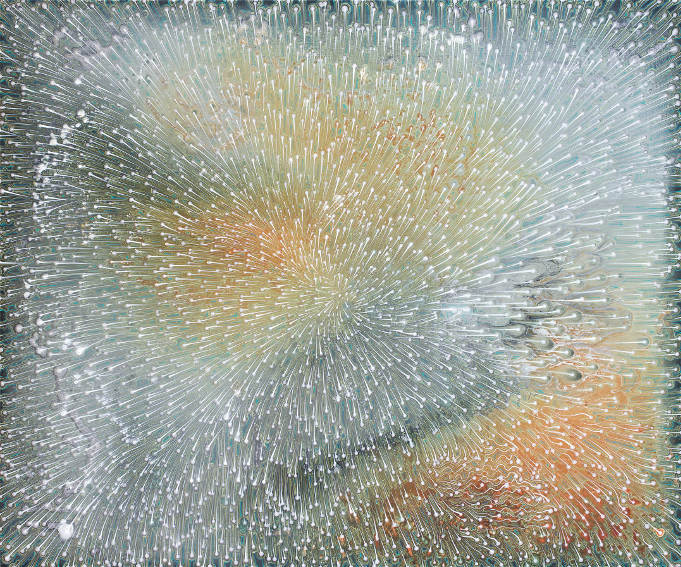
Barbara Takenaga - Outset, 2017. Acrylic on linen. 45 x 54 inches. © Barbara Takenaga. Photo courtesy DC Moore Gallery
“Langwidere consists of thirty variations of the same composition, each one painted on a 12” x 10” wood panel. Takenaga chose the number 30, but she just as easily could have painted 300, or 3000 variations of the composition. The exercise is part of a longstanding tradition in the arts. In 1512, the Dutch scholar Desiderius Erasmus Roterodamus published a book titled Copia: Foundations of the Abundant Style, which included a chapter with 195 variations of the Latin sentence, “Tuae litterae me magnopere delectarunt,” or, “Your letter greatly delighted me.” In 1947, French novelist Raymond Queneau published “Exercises in Style,” a book consisting of 99 variations on a short story in which the narrator sees two men arguing on a bus, and then later sees one of the men having a discussion about adding a button to his jacket. Takenaga created this series of paintings in the same spirit of an exercise in style. It is an exercise in composition that demonstrates that she is well aware of the infinite possibilities that every choice implies. The exercise proves that when we look at any work she has painted since, it is her sense of artistry and intelligence alone that determined that out of infinite other potentialities, this manifestation of the painting is that best version that could exist.
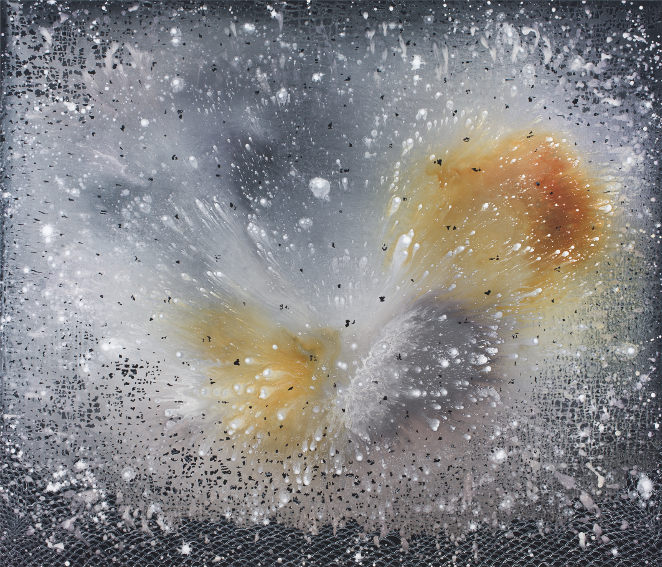
Barbara Takenaga - Rust Never Sleeps, 2018. Acrylic on linen. 60 x 70 inches. © Barbara Takenaga. Photo courtesy DC Moore Gallery
Manifold Realities
As with many of her other past works, a lot of the new works in Outset bring to mind something that is in the process of becoming something else. The images seem to be in a state of transition. Such is the case with the largest new painting in this exhibition, titled “Manifold 5” (2018). This five-paneled piece measures a massive 70” x 225.” The composition is dominated by organic, swirling blue and silver bands. Within the bands float dozens of variations of a single image: something resembling a splash, or an explosion, emanating from concentric rings of dots that bring to mind little universes. It is an undeniably dynamic image, one that could be perceived as both creative and destructive. This could be an image of things in their primordial beginnings, or things coming to their violent end, or perhaps both.

Barbara Takenaga - Manifold 5, 2018. Acrylic on linen. 70 x 225 inches. © Barbara Takenaga. Photo courtesy DC Moore Gallery
Yet two other works in this show possess an altogether different kind of vibe. The two-paneled “Atmosphere L and R” (2017), and the painting titled “Aeaea” (2018), which is named for the island on which Circe, the mythical Greek goddess of magic lives, call to mind something static, almost geologic. Rather than feeling that I am looking at processes in action, these paintings make me feel that I am looking at the result of past processes. They remind me of nature in an almost anthropological way. Something about these works made me less introspective, and more outward looking. They connect me to something outside myself. Critically speaking, this is not easy for a painter to do. For that reason, as well as for the technical prowess that she has demonstrated in this body of work, I believe Takenaga has demonstrated definitively with this exhibition that she is amongst the best painters of her generation. Barbara Takenaga: Outset is on view at DC Moore Gallery in New York through 6 October 2018.
Featured image: Barbara Takenaga - Arch, 2018. Acrylic on linen. 45 x 54 inches. © Barbara Takenaga. Photo courtesy DC Moore Gallery
By Phillip Barcio
